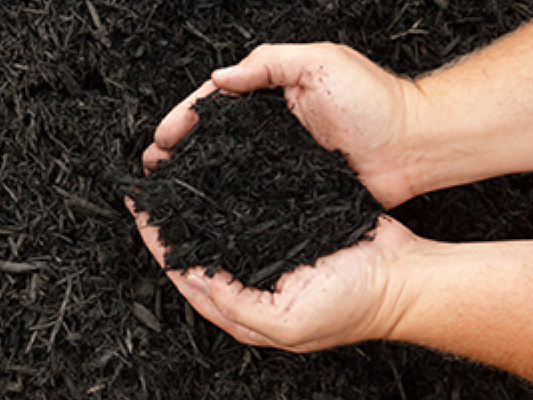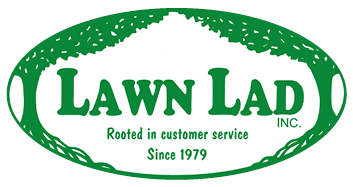MULCH INSTALLATION
The Big Benefits of mulch
Mulch offers several benefits, including weed suppression, moisture retention, temperature moderation and improved aesthetics. Mulch is often overused and actually is not a landscape element but a soil amendment that replaces organic matter and adds nutrients to the garden. Organic matter needs to be replenished because it continuously breaks down and your garden will reward you when you use the right mulch and install it properly.
Timing
Springtime is often correlated with time to mulch, but just because the shopping plaza and your neighbor are mulching, doesn’t mean your beds are ready yet for a fresh layer of mulch. Ideally, mulch is installed when the existing mulch has become mostly depleted. Mulching too soon and too often leads to excessive mulch which can result in plant decline.
Aged mulch that has smaller particles and appears more like compost will break down more quickly and may need to be replenished each season, while chunkier wood products may take a year or longer to break down.
Selecting mulch
Mulch products come from various sources. The two most common are wood waste and bark mulch. There are key differences between the options.
Bark mulch – After the sawmills remove the hardwood bark, it is aged for 6 to 12 months to make sure it won’t harm your plants. This aged hardwood bark mulch is ideal since it won’t burn your plants. It knits together and holds well in place, providing good moisture retention and weed suppression without readily washing away.
Wood waste mulch – This is the most common, and comes from tree logs, ground up pallets and other wood by-products. This dyed mulch is not aged is slow to decompose and return any organics to the soil, and tends to float and move more readily making it less ideal for weed suppression and moisture retention.
Other mulch – Composted products, such as leaf humus, landscape compost and branded products like SweetPeet® are also available. Generally, these types of compost are best used to directly amend the soil by incorporating it into the native soil to improve the organic content. Know the source of your organic compost – not all organic or compost products are equal. Some may not have been aged sufficiently, which will cause issues for existing and new plantings.

Healthy soil
Most soil is healthiest when it contains at least 5% organic matter, though annual and perennial beds require more. Organic matter reduces soil compaction, which improves air and water flow. Certain mulches are rich in nutrients that benefit the plants. Organic matter needs to be replenished periodically because it decomposes. In nature, this process occurs naturally when plant debris is recycled through the decomposition process. That process takes time – time we don’t have in our gardens. In our urban landscapes and gardens, it is necessary to remove leaves, branches and plant debris from our landscapes because they are unsightly, can be good hiding places for pests, and may smother or damage plants. By removing the leaves and debris and composting them off-site, we continue the cycle when we return the compost, leaf humus and other products to our landscapes. By replenishing organic matter into our beds with materials that have begun to decompose, we speed the cycle and provide many benefits to our urban landscapes.
Applications
Soil amendments may be applied and incorporated into the landscape by top-dressing, forking in, or rototilling.
Top dressing – This is the most common method. Mulch is used to fill in areas of the landscape that may not be fully planted, mitigating weeds and aiding in moisture retention. Shredded hardwood bark mulches are great for this, but leaf compost and other composted material can also be used.
Forking in – Organic matter is gently worked into the soil with a pitchfork. This method is best for adding modest amounts of material that need to be quickly incorporated into the soil.
Rototilling – This method is used for new or empty beds that need a fresh supply of organic material for new plantings where there is little risk of damaging surrounding plants.
Delicate balance
Generally, soil amendments should be added whenever the landscape has become depleted. For hardwood or bark mulch, no more than 1.5” to 2” of mulch should be applied at a time, keeping total accumulation at 2” or less. Excessive mulch can trap moisture in the soil during heavy wet periods leading to root rot; and it can prevent moisture from getting to the roots during drier periods.
BEFORE YOU MULCH
For mulch to be most effective, take time to properly prepare your beds before you invest the labor and cost of materials for the mulch installation. Bed areas should be free of weeds and other undesirable vegetation. Establish a deep bed edge to separate lawn from bed areas. The bed edge will not only prevent mulch from washing into the lawn, but it will also minimize grass from spreading into the bed. Rake over the bed to distribute any old or remaining mulch and smooth the bed out to level uneven areas.
INSTALLATION SUGGESTIONS
In open areas you can dump small piles and then spread, while in tight areas you may need to place smaller piles by using a pitchfork or shovel. Spread with your hands or a rake. Add mulch so that you don’t have more than about 2.0” of total mulch depth. Do not allow mulch to pile up on the base or trunks of plants; use your finger to swipe around the base (circumference) of the plant to create air space (one or two finger widths). Use the back of a leaf rake to gently distribute and even out the mulch for a final smooth and neat appearance.
There is more to mulching and adding soil amendments than just spreading wood chips over a bed. Mulching is an essential cultural practice for a healthy, beautiful landscape.
Need more information or help mulching and preparing garden beds? Let’s talk!
Rooted in Customer Service Since 1979

Office/Shop Address: 441 South Green Road, South Euclid, Ohio 44121
Mailing Address: 471 Chagrin River Road, Cleveland, Ohio 44040
(216) 371-1935 • info@lawnlad.com
©Lawn Lad, Inc. 2023
